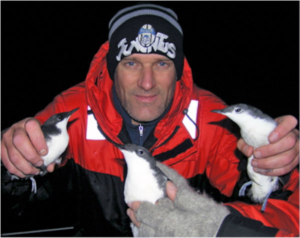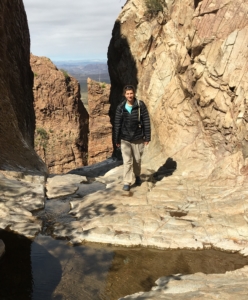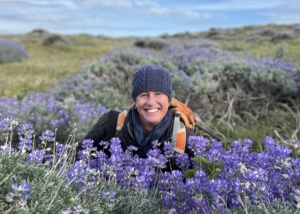Staff
 Mike is the Executive Director of CIES, overseeing the day-to-day operations for the organization since January 2017. He received a BS from the University of Vermont and a MS in Natural Resources from Humboldt State University. Mike has over 25 years in natural resource management, research and consulting experience throughout the western United States with an emphasis on threatened and endangered species, wetlands, and birds (particularly seabirds and waterfowl). His interest in natural resources and wildlife ecology began as a young boy hunting and fishing with his father in Vermont. Since 2010, Mike has worked for CIES as a seabird biologist studying Ashy Storm-Petrels, Scripps’s Murrelets and Guadalupe Murrelets. Mike lives in Davis, CA with his two boys (Kyle and Cody). In their spare time, the Parkers enjoy being outdoors while they bike, hike, rock climb, camp, fish, bird watch and rock hound. Mike also laces up his skates once a week to play ice hockey – something he can’t seem to get out of his system.
Mike is the Executive Director of CIES, overseeing the day-to-day operations for the organization since January 2017. He received a BS from the University of Vermont and a MS in Natural Resources from Humboldt State University. Mike has over 25 years in natural resource management, research and consulting experience throughout the western United States with an emphasis on threatened and endangered species, wetlands, and birds (particularly seabirds and waterfowl). His interest in natural resources and wildlife ecology began as a young boy hunting and fishing with his father in Vermont. Since 2010, Mike has worked for CIES as a seabird biologist studying Ashy Storm-Petrels, Scripps’s Murrelets and Guadalupe Murrelets. Mike lives in Davis, CA with his two boys (Kyle and Cody). In their spare time, the Parkers enjoy being outdoors while they bike, hike, rock climb, camp, fish, bird watch and rock hound. Mike also laces up his skates once a week to play ice hockey – something he can’t seem to get out of his system.  Darrell received a BS in Wildlife and Fisheries Biology at UC, Davis in 1989. He has conducted seabird research in the North Pacific Ocean since 1991, and since 1994 has concentrated his studies on the conservation of Synthlibormaphus murrelets. In 1995, he developed the night-lighting at-sea capture technique which has been essential in many demographic, population monitoring, radio telemetry, and genetic studies of Synthliboramphus and Brachyramphus murrelets. In 2000, he also developed the spotlight survey technique which he has used to determine the distribution and status of Scripps’s and Guadalupe murrelet colonies throughout their range in California, USA and Baja, California, Mexico. Darrell led or collaborated in radio telemetry studies of Scripps's Murrelets (1995-97) and Cassin’s Auklets (1999-2000) in southern California, and Marbled Murrelets in southeast Alaska (1998, 2005-2008) and Oregon (2016-ongoing). From 2000 to 2014, he conducted an important population monitoring study of Scripps’s Murrelets at Anacapa Island, California documenting the improvement in hatching success and colony growth following the eradication of introduced rats. In 2007, he was the lead author of published a manual sponsored by the United Nations Food and Agriculture Organization that described research techniques for use in field studies of bird populations and ecological aspects of avian influenza viruses. Darrell has visited Asia annually since 2011 to assist in numerous studies using the night-lighting and spotlight survey techniques to investigate the distribution and status of Japanese Murrelets and Ancient Murrelets, including studies at Birojima (Miyazaki-ken), Eboshijima and Okinoshima (Fukuoka-ken), Kaminoseki (Yamaguchi-ken), Teuri Island (Hokkaido) and Tobishima (Yamagata-ken) in Japan and Gugul-do/Chibal-do (Shinan County) in South Korea. He is currently revising the Scripps’s Murrelet account for the Birds of North America series and is probably the only person in the world to have captured all 5 species of Synthliboramphus murrelets.
Darrell received a BS in Wildlife and Fisheries Biology at UC, Davis in 1989. He has conducted seabird research in the North Pacific Ocean since 1991, and since 1994 has concentrated his studies on the conservation of Synthlibormaphus murrelets. In 1995, he developed the night-lighting at-sea capture technique which has been essential in many demographic, population monitoring, radio telemetry, and genetic studies of Synthliboramphus and Brachyramphus murrelets. In 2000, he also developed the spotlight survey technique which he has used to determine the distribution and status of Scripps’s and Guadalupe murrelet colonies throughout their range in California, USA and Baja, California, Mexico. Darrell led or collaborated in radio telemetry studies of Scripps's Murrelets (1995-97) and Cassin’s Auklets (1999-2000) in southern California, and Marbled Murrelets in southeast Alaska (1998, 2005-2008) and Oregon (2016-ongoing). From 2000 to 2014, he conducted an important population monitoring study of Scripps’s Murrelets at Anacapa Island, California documenting the improvement in hatching success and colony growth following the eradication of introduced rats. In 2007, he was the lead author of published a manual sponsored by the United Nations Food and Agriculture Organization that described research techniques for use in field studies of bird populations and ecological aspects of avian influenza viruses. Darrell has visited Asia annually since 2011 to assist in numerous studies using the night-lighting and spotlight survey techniques to investigate the distribution and status of Japanese Murrelets and Ancient Murrelets, including studies at Birojima (Miyazaki-ken), Eboshijima and Okinoshima (Fukuoka-ken), Kaminoseki (Yamaguchi-ken), Teuri Island (Hokkaido) and Tobishima (Yamagata-ken) in Japan and Gugul-do/Chibal-do (Shinan County) in South Korea. He is currently revising the Scripps’s Murrelet account for the Birds of North America series and is probably the only person in the world to have captured all 5 species of Synthliboramphus murrelets.  Katy is the Operations and Development Manager for CIES. She began volunteering on a number of different projects within the Channel Islands when she was 17 and fell in love with the work. Katy gained a love of the outdoors on southern Delaware's Indian River; coneoing, kayaking, and trudging through the mud to explore the unique marsh ecosystem where she grew up. After graduating from New York University in 2011 with a BA, she moved to Ventura, CA shortly after to begin working full time with CIES. You can find her coordinating volunteers on the islands, multitasking various spreadsheets in the office, arranging transportation, out in the field conducting research, and doing whatever she can to make sure that the projects continue to operate smoothly and seamlessly. In her freetime you will most likely find her cooking up something in the kitchen, gardening, or with an instrument in hand.
Katy is the Operations and Development Manager for CIES. She began volunteering on a number of different projects within the Channel Islands when she was 17 and fell in love with the work. Katy gained a love of the outdoors on southern Delaware's Indian River; coneoing, kayaking, and trudging through the mud to explore the unique marsh ecosystem where she grew up. After graduating from New York University in 2011 with a BA, she moved to Ventura, CA shortly after to begin working full time with CIES. You can find her coordinating volunteers on the islands, multitasking various spreadsheets in the office, arranging transportation, out in the field conducting research, and doing whatever she can to make sure that the projects continue to operate smoothly and seamlessly. In her freetime you will most likely find her cooking up something in the kitchen, gardening, or with an instrument in hand.  Jim Howard is the lead seabird biologist for CIES on the Channel Islands National Park seabird projects. He has worked for CIES since October 2012. Originally from Shelton, Washington, Jim spent his childhood in the creek behind his house, where his fascination with nature began. After graduating from Western Washington University with a BS in Biology, Jim spent the next 9 years working on reintroduction and restoration projects for many endangered species, including the California Condor in Big Sur, California, the Ozark Hellbender in Southwestern Missouri, and the Kemp’s Ridley Sea Turtle at North Padre Island, Texas. Jim’s favorite part of the work is the variety of jobs that need to be performed to be successful. In a single day, he can operate a Zodiac boat, a pedestal crane, and a fire pump; work in the plant nursery, search for seabird nests, pull weeds, plant plants, and mist-net storm-petrels. Every day is different, and there are always new challenges and adventures! When not on the islands, Jim spends most of his free time chasing birds around Ventura County and reading supernatural and zombie apocalypse novels.
Jim Howard is the lead seabird biologist for CIES on the Channel Islands National Park seabird projects. He has worked for CIES since October 2012. Originally from Shelton, Washington, Jim spent his childhood in the creek behind his house, where his fascination with nature began. After graduating from Western Washington University with a BS in Biology, Jim spent the next 9 years working on reintroduction and restoration projects for many endangered species, including the California Condor in Big Sur, California, the Ozark Hellbender in Southwestern Missouri, and the Kemp’s Ridley Sea Turtle at North Padre Island, Texas. Jim’s favorite part of the work is the variety of jobs that need to be performed to be successful. In a single day, he can operate a Zodiac boat, a pedestal crane, and a fire pump; work in the plant nursery, search for seabird nests, pull weeds, plant plants, and mist-net storm-petrels. Every day is different, and there are always new challenges and adventures! When not on the islands, Jim spends most of his free time chasing birds around Ventura County and reading supernatural and zombie apocalypse novels.  Amelia Jade DuVall joined CIES in 2016 as a Biological Field Technician. She holds a degree in Environmental Studies and a minor in Writing from the University of California, Santa Barbara, where she graduated with honors and received recognition as Outstanding Senior in her graduating class in the Environmental Studies department. She is currently pursuing her phD at the University of Washington's School of Aquatic and Fishery Sciences and continues to stay involved and partner with CIES on seabird projects within Channel Islands National Park. She first became involved with native habitat restoration as an intern at Coal Oil Point Reserve, a protected coastal-strand environment near Santa Barbara, California. Since then, she has spent several years working on land conservation and restoration for various local organizations.
Amelia Jade DuVall joined CIES in 2016 as a Biological Field Technician. She holds a degree in Environmental Studies and a minor in Writing from the University of California, Santa Barbara, where she graduated with honors and received recognition as Outstanding Senior in her graduating class in the Environmental Studies department. She is currently pursuing her phD at the University of Washington's School of Aquatic and Fishery Sciences and continues to stay involved and partner with CIES on seabird projects within Channel Islands National Park. She first became involved with native habitat restoration as an intern at Coal Oil Point Reserve, a protected coastal-strand environment near Santa Barbara, California. Since then, she has spent several years working on land conservation and restoration for various local organizations.  Jay Woolsey was born in San Diego, California learning all about intertidal ecology and invasive species issues from an early age. In 2016 he graduated from CSU Channel Islands with a BS in Environmental Science and Resource Management. Jay's senior thesis was in Channel Islands National Park where he monitored island oak trees on Black Mountain. After that Jay was contracted for multiple invasive species removal projects and mapping contracts. These contracts would eventually lead to CIES and habitat restoration on Anacapa and Santa Cruz Islands. Jay spends most of his free time barbecuing, kayaking, hiking and backpacking throughout the Southwest of the United States.
Jay Woolsey was born in San Diego, California learning all about intertidal ecology and invasive species issues from an early age. In 2016 he graduated from CSU Channel Islands with a BS in Environmental Science and Resource Management. Jay's senior thesis was in Channel Islands National Park where he monitored island oak trees on Black Mountain. After that Jay was contracted for multiple invasive species removal projects and mapping contracts. These contracts would eventually lead to CIES and habitat restoration on Anacapa and Santa Cruz Islands. Jay spends most of his free time barbecuing, kayaking, hiking and backpacking throughout the Southwest of the United States.  Born and raised in beautiful Ventura County, Destinee's passion for nature developed at an early age. She spent most of her time surrounded by the Santa Monica mountains and exploring the beaches. In 2018, Destinee was accepted into an internship program with the California Conservation Corps. This opportunity allowed her to work alongside several agencies such as the National park service, California state parks, local cities, and local nonprofit organizations. During this internship she was able to learn about restoration and fall in love with it. Following that internship, Destinee began to volunteer for restoration programs which is when she discovered CIES. Her passion for our native flora and interest in learning about the importance of biodiversity and restoration grew and Destinee joined the team in spring of 2021 as the Anacapa Island Restoration Biological technician. In her spare time you’ll find her hiking the beautiful mountains or getting her toes sandy on the beach.
Born and raised in beautiful Ventura County, Destinee's passion for nature developed at an early age. She spent most of her time surrounded by the Santa Monica mountains and exploring the beaches. In 2018, Destinee was accepted into an internship program with the California Conservation Corps. This opportunity allowed her to work alongside several agencies such as the National park service, California state parks, local cities, and local nonprofit organizations. During this internship she was able to learn about restoration and fall in love with it. Following that internship, Destinee began to volunteer for restoration programs which is when she discovered CIES. Her passion for our native flora and interest in learning about the importance of biodiversity and restoration grew and Destinee joined the team in spring of 2021 as the Anacapa Island Restoration Biological technician. In her spare time you’ll find her hiking the beautiful mountains or getting her toes sandy on the beach.
(bio coming soon)
 Michelle discovered her passion for habitat restoration when she planted her first cactus on San Nicolas Island as a volunteer with Channel Islands Restoration. She was fortunate to receive an internship with Channel Islands NPS, where she took part in various restoration projects on the islands and discovered that a career could be made from the work that she found so fulfilling. After returning to school to receive her BS in Environmental Science and Resource Management at CSU Channel Islands, Michelle began working with CIES in 2022 as the lead Restoration Ecologist on the Cloud Forest Restoration Project, occurring on Santa Rosa Island. When she is not working to create a healthy ecosystem on Santa Rosa, Michelle enjoys surfing, biking, and snuggling with her fur babies.
Michelle discovered her passion for habitat restoration when she planted her first cactus on San Nicolas Island as a volunteer with Channel Islands Restoration. She was fortunate to receive an internship with Channel Islands NPS, where she took part in various restoration projects on the islands and discovered that a career could be made from the work that she found so fulfilling. After returning to school to receive her BS in Environmental Science and Resource Management at CSU Channel Islands, Michelle began working with CIES in 2022 as the lead Restoration Ecologist on the Cloud Forest Restoration Project, occurring on Santa Rosa Island. When she is not working to create a healthy ecosystem on Santa Rosa, Michelle enjoys surfing, biking, and snuggling with her fur babies.
(bio coming soon)
(bio coming soon)
